7 MIN READ
Assessing Nutrient Availability for Corn
May 15, 2024
- Assessing soil nutrient levels and understanding nutrient availability is important to obtaining high corn yield potential.
- Research suggests that corn products with transgenic insect protection, such as rootworm resistance, may have increased root growth leading to increased nutrient uptake and yield potential.1
- An increase in nutrient use may lead to changes in fertilizer recommendations.
Soil Testing and pH
Managing soil fertility begins with soil testing. Soil test results help establish nutrient levels in the soil that allow for locally calibrated fertilizer recommendations. Soil testing should be performed at least once every three years.
Along with providing soil nutrient levels, soil testing assesses soil pH values which measure soil acidity or alkalinity that can greatly impact crop growth (Figure 1). Optimal soil nutrient availability for corn occurs within a soil pH range of 6.0 to 7.0. When soil pH falls below 5.5, corn plants may show signs of nutrient deficiencies. Primary macronutrients (nitrogen, phosphorus, and potassium) and secondary macronutrients (sulfur, magnesium, and calcium) can become less available to corn plants in low soil pH environments. In addition to reducing nutrient availability, low soil pH can also increase the availability of aluminum and manganese, which can result in plant toxicity and possible plant death. Although necessary in medium- to high-yield environments, a fertilizer application can also increase the probability of soil acidity.
Soil test results can be used to determine lime requirements for decreasing soil acidity. Soil testing laboratories use buffer pH to determine lime requirements. Buffer pH is a laboratory-derived value used to evaluate the ability of a soil to respond to liming. The larger the difference is between the original soil pH and buffer pH, the more responsive a soil will be to lime application, and the lower amount of lime required to raise soil pH. Lime is recommended to be applied in the fall to allow adequate time to neutralize soil acidity. If lime is unable to be applied in the fall, a spring application is recommended.2
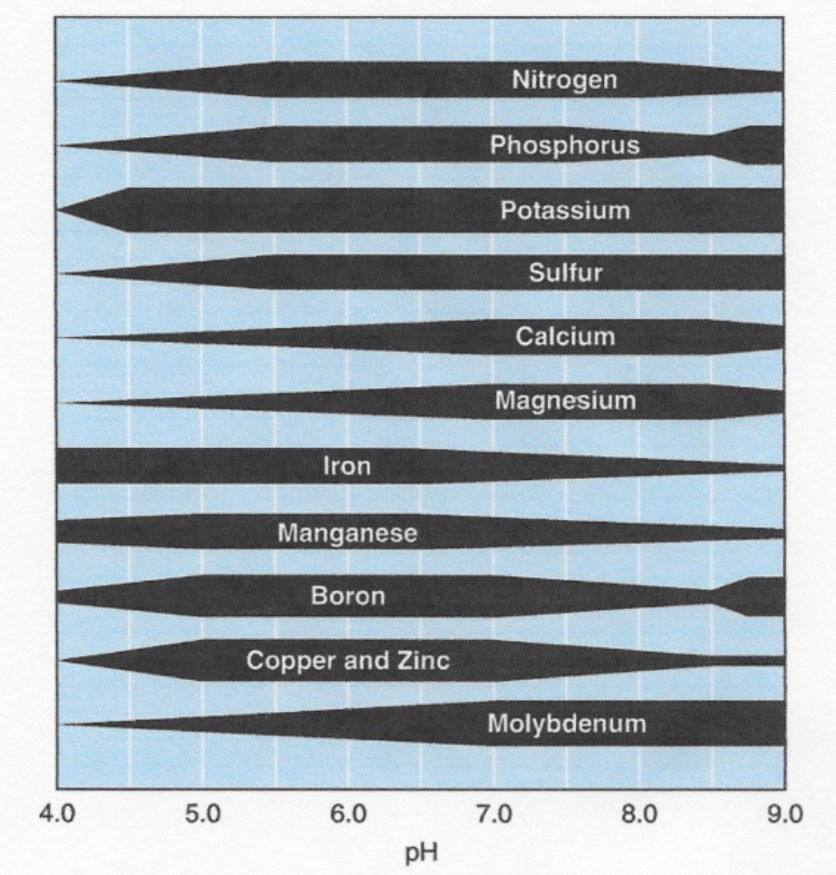
Corn Nutrient Use
Nitrogen (N) should be applied according to crop need and is recommended to be applied two to three times per season depending on growing conditions. A split application can reduce the likelihood of N loss from leaching and denitrification during typical wet spring weather. Corn extracts only 15% of required N prior to rapid vegetative growth. To help maximize potential yield, N should be applied prior to rapid vegetative growth, or around the V5 to V8 growth stages. Synchronizing N application timing with rapid N uptake by corn can help improve N use efficiency. A corn plant requires the most N at the V10 growth stage, which occurs about 40 days after plant emergence.2
Inadequate fertilization and leaching from heavy rainfall can result in N deficiency. Symptoms appear on leaves as overall light green to yellow coloration and may be observed in a “v” shaped pattern that starts at the tip and progresses toward the leaf collar (Figure 2).3
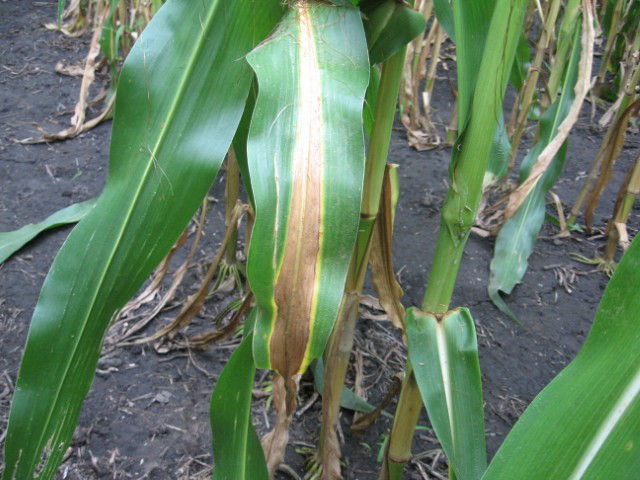
Phosphorus (P) can be applied either in the fall prior to tillage or in the spring depending on local conditions. The nutrient is nearly immobile in the soil and incorporation is recommended within the corn root zone. Fertigation may also be an effective method to incorporate P deep into the root zone; however, emitter clogging is a concern.4 Corn often responds well to placing P in the root zone as a starter fertilizer at planting. Phosphorus can be injected as a sidedress treatment to help the nutrient reach the corn roots, but care should be taken not to damage roots in the process.
Phosphorus deficiency typically occurs in young corn plants after a period of cool soil temperatures. The developing corn roots are unable to uptake enough P for growth, resulting in P deficiency and delayed growth. Symptoms include dark green leaves and purple margins on older leaves with no symptoms on new, emerging leaves (Figure 3). When optimum growing conditions occur, roots continue to grow and uptake P resulting in symptoms fading and corn resuming normal growth.2
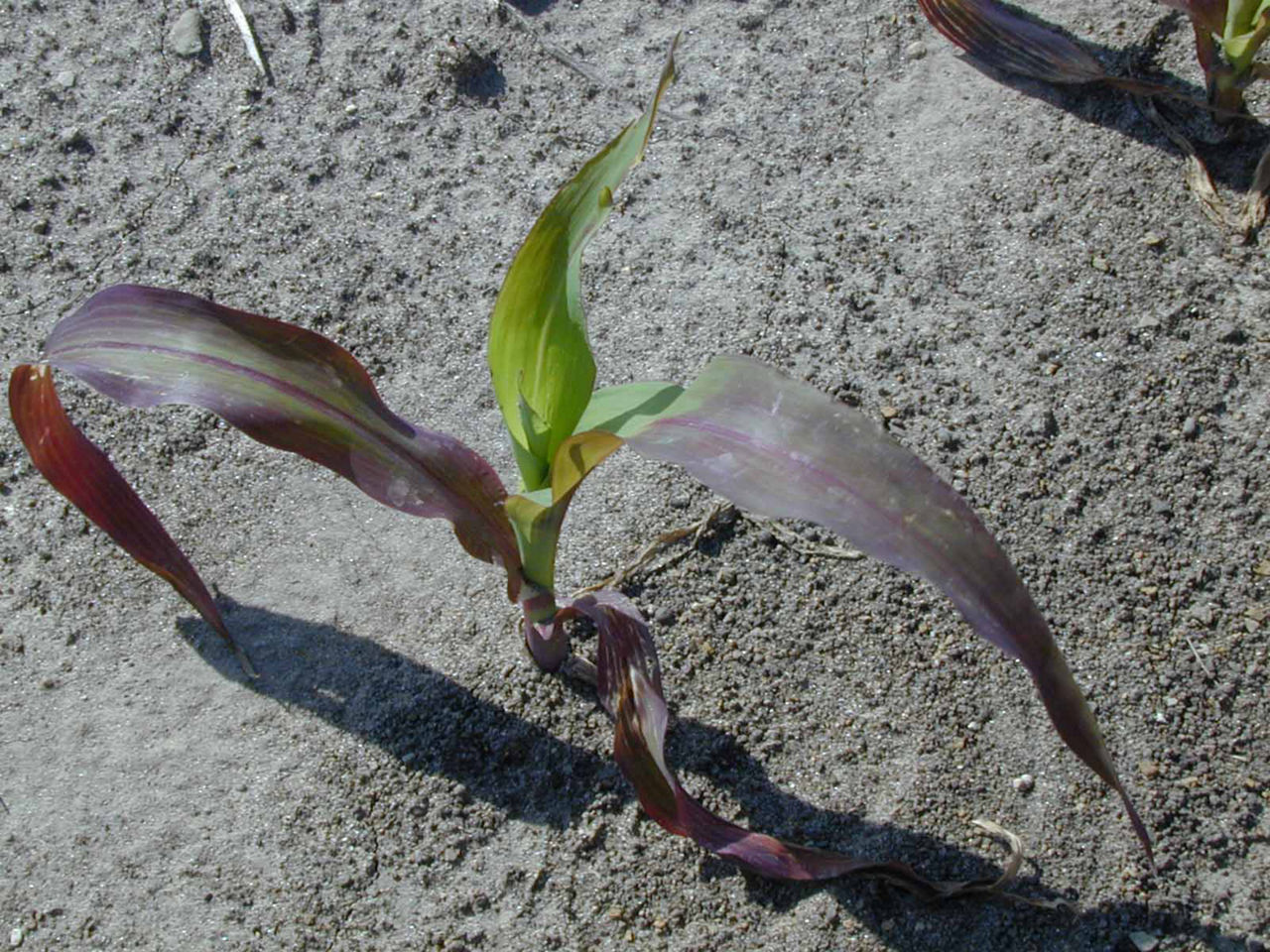
Potassium (K) requirements are higher in production environments with heavy crop removal, such as silage production. Soybean rotations must also be considered as soybean seed production requires more K and will deplete the soil at a faster rate than other crops. Like P, K fertilizer may be applied in the fall as it is relatively immobile in the soil, but caution should be taken when applying K to sandy soils as leaching may occur. Potassium may also be applied in the spring or in-season. A starter fertilizer may help improve N, P, and K availability, especially in conservation tillage systems.
Potassium deficiency can be observed on older leaves as chlorotic (yellow), then necrotic (dead) leaf tissue at the leaf tip and migrating toward the stalk (Figures 4 and 5). Potassium is essential for the plant to move energy from the leaves for grain fill. If K is limited by drought or other stress, silk emergence may be delayed, and ears with unfilled tips may result.5 Low K levels can result in yellow leaf margins on lower, older leaves. Because K may be recycled back into the soil through crop residue, deficiencies are common when crop residue is removed from the field.
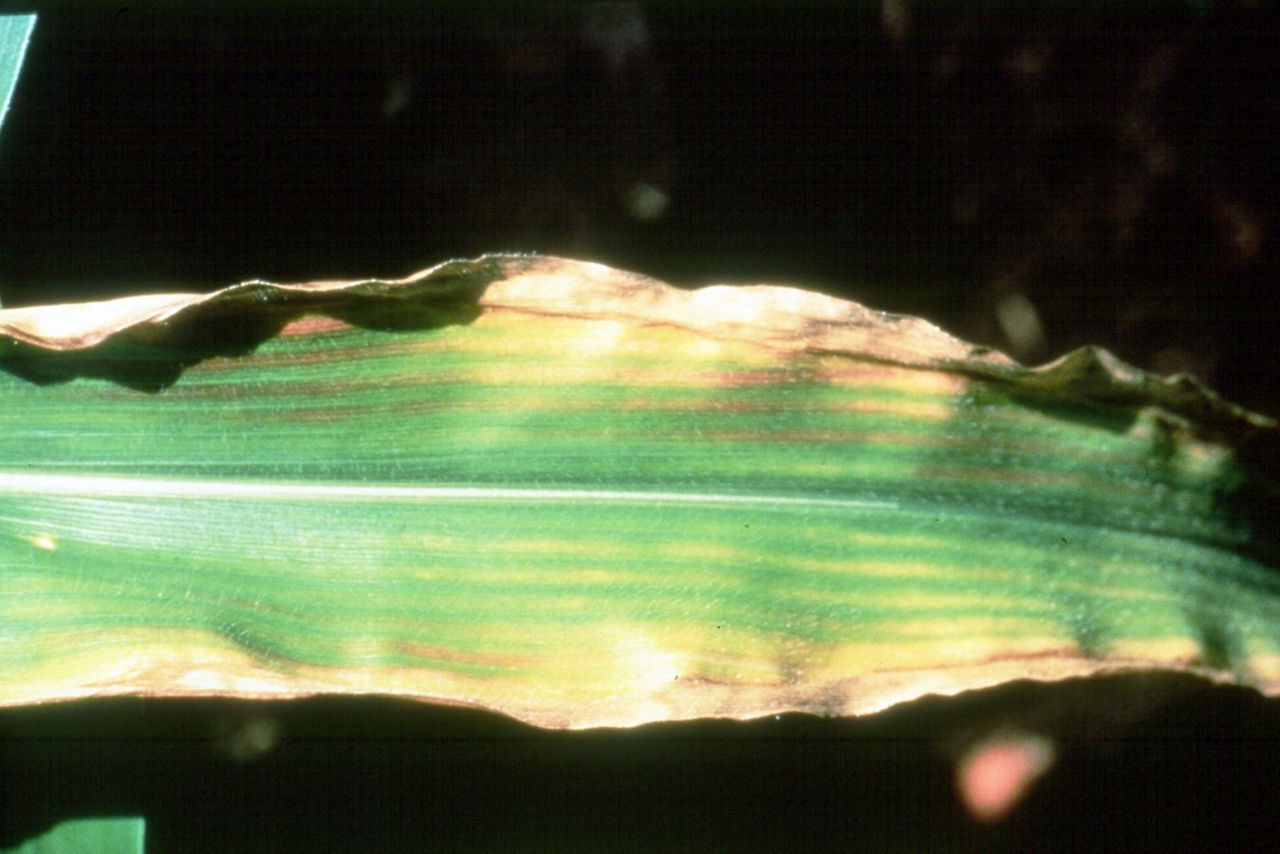
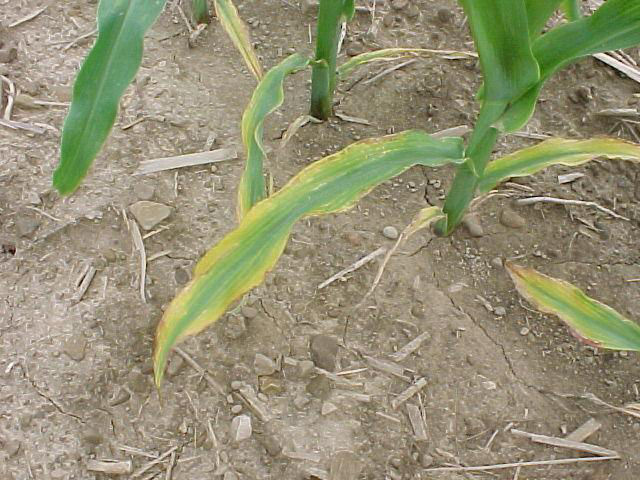
Other Important Nutrients and Considerations
High corn yields can be accompanied with a significant drop in soil nutrient levels, especially P, K, sulfur (S), and zinc (Zn).1 Manganese (Mn) can also have limited availability in some soils. Growers need to consider the impact of increased yields and employ appropriate fertilizer strategies to help ensure that adequate nutrient levels are available to the crop. Although the uptake of nutrients such as S, Zn, and Mn make up less than one percent of fertilizer applied in corn, they are critical for corn development, and it is important to identify and manage deficiency symptoms.6
Sulfur deficiency may occur more often in sandy, acidic soils that are low in organic matter. Cool and wet conditions usually found in the spring can also increase the chance of S deficiency. Symptoms include general yellowing, possibly with yellow-white interveinal striping (Figure 6). Symptoms appear first on younger leaves as S is relatively immobile in the plant. Plants may also be stunted. If symptoms are a result of cool, wet soils, corn may recover as soon as soil conditions improve. Sampling the ear leaf is the accepted sampling method to quantify a S deficiency.
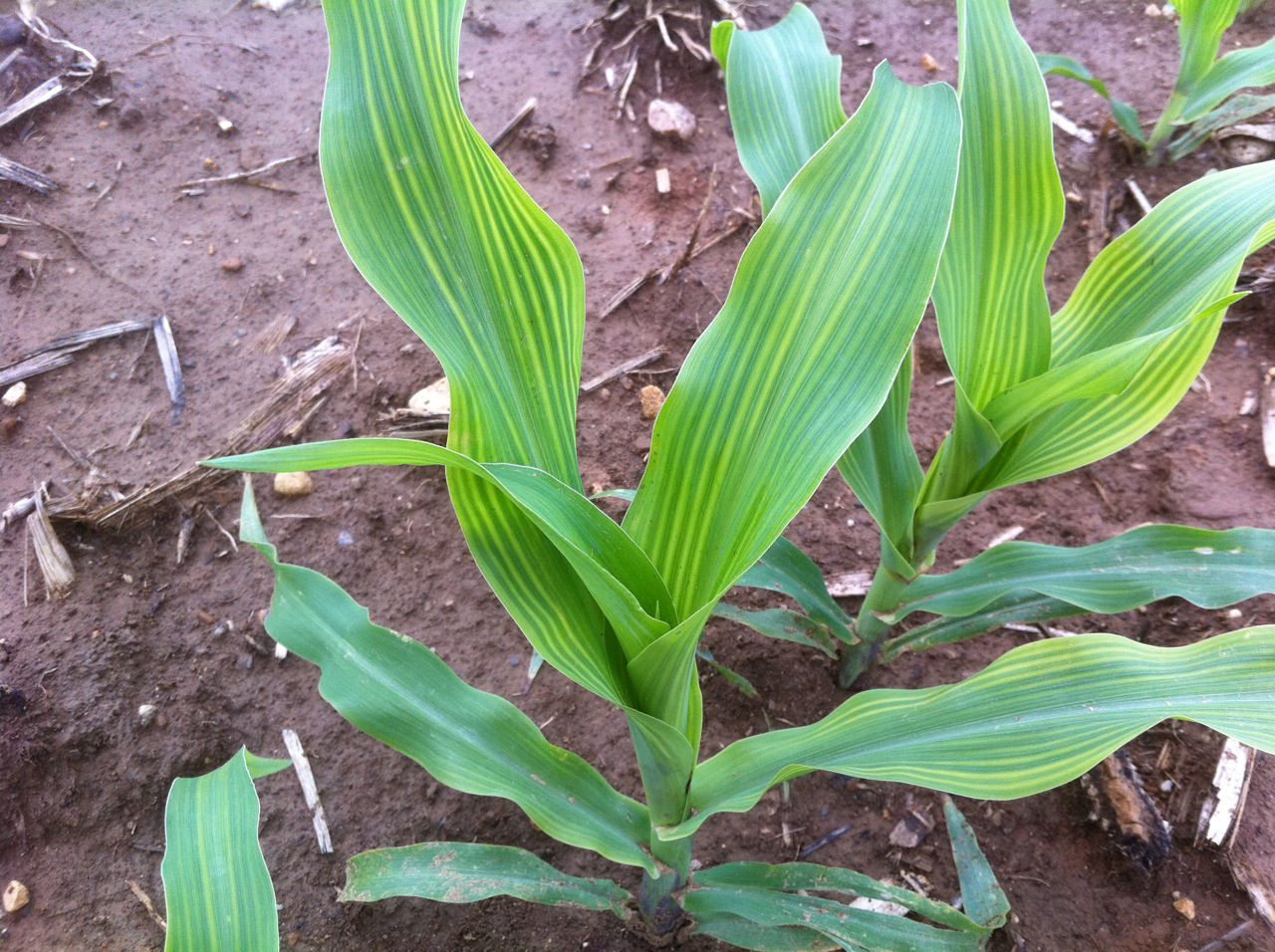
Like S, Zn deficiency also occurs more frequently in sandy soils low in organic matter during cool, wet conditions. However, unlike S deficiency, Zn deficiency is more common in alkaline soils. Zinc is also relatively immobile in the plant, so symptoms appear on young leaves as whitish bands that start at the base of the leaf and move toward the tips (Figure 7). Leaf margins and tips typically remain green. Symptoms may be observed several weeks after planting. Internodes may be shortened, but corn typically recovers when favorable conditions return. Tissue sampling can confirm a Zn deficiency, as in some cases it can be confused with an S deficiency.

Manganese is often immobile in corn and can become deficient in high pH soils that may also be high in organic matter or are considered peat or muck soils. Symptoms may be observed in younger plants as olive-colored streaks.3
High-yield corn production environments have benefited from increased yield potential from biotechnology traits and rapid advancement in crop genetics. To achieve this increased yield potential, changes in fertility should be considered. It is important to fertilize according to soil test recommendations and sample soil annually to help ensure adequate nutrients are available as soil may be depleted faster in high-yield environments. Soil and tissue analysis, nutrient removal, and realistic yield goals can be used to determine the amount of fertilizer needed. High yield potential can be realized when nutrients are applied according to recommendations and available when nutrient demands are highest.
Sources
1Bender, R., Haegele, J., Ruffo, M., and Below, F. 2013. Nutrient uptake, partitioning, and remobilization in modern, transgenic insect-protected maize hybrids. Agronomy Journal 105: 161-170.
2Larson, E. and Oldham, L. 2021. Corn fertilization. Mississippi State University. Publication P3591. https://extension.msstate.edu/sites/default/files/publications/information-sheets/P3591_corn_web.pdf.
3Sawyer, J. 2010. Nutrient deficiencies and application injuries in field crops. Integrated Pest Management. Iowa State University Extension and Outreach. IPM 42. https://store.extension.iastate.edu/Product/Nutrient-Deficiencies-and-Application-Injuries-in-Field-Crops-Integrated-Pest-Management
4Xiao, Y., Puig-Bargués, J., Zhou, B., Li, Q., and Li, Y. 2020. Increasing phosphorus availability by reducing clogging in drip fertigation systems. Journal of Cleaner Production. Volume 262. Science Direct. Elsevier Ltd.
5Quinn, D. 2023. Drought stress and Indiana corn in 2023. Pest & Crop Newsletter. Purdue University. https://extension.entm.purdue.edu/newsletters/pestandcrop/article/drought-stress-and-indiana-corn-in-2023/
6Mallarino, A.P., Oltmans, R.R., Prater, J.R., Villavicencio, C.X., and Thompson, L.B. 2011. Nutrient uptake by corn and soybean, removal, and recycling with crop residue. 2011 Integrated Crop Management Conference: 103-113. Iowa State University. https://www.agronext.iastate.edu/soilfertility/info/mallarino-2.pdf
Web sources verified 3/26/24. 1213_72921
Seed Brands & Traits
Crop Protection
Disclaimer
Always read and follow pesticide label directions, insect resistance management requirements (where applicable), and grain marketing and all other stewardship practices.
©2024 Bayer Group. All rights reserved.